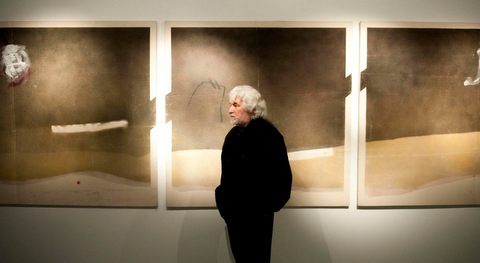- Region
- Águilas
- Alhama de Murcia
- Jumilla
- Lorca
- Los Alcázares
- Mazarrón
- San Javier
-
ALL AREAS & TOWNS
- AREAS
- SOUTH WEST
- MAR MENOR
- MURCIA CITY & CENTRAL
- NORTH & NORTH WEST
- TOWNS
- Abanilla
- Abarán
- Aguilas
- Alamillo
- Alcantarilla
- Aledo
- Alhama de Murcia
- Archena
- Balsicas
- Blanca
- Bolnuevo
- Bullas
- Cañadas del Romero
- Cabo de Palos
- Calasparra
- Camping Bolnuevo
- Campo De Ricote
- Camposol
- Canada De La Lena
- Caravaca de la Cruz
- Cartagena
- Cehegin
- Ceuti
- Cieza
- Condado de Alhama
- Corvera
- Costa Cálida
- Cuevas De Almanzora
- Cuevas de Reyllo
- El Carmoli
- El Mojon
- El Molino (Puerto Lumbreras)
- El Pareton / Cantareros
- El Raso
- El Valle Golf Resort
- Fortuna
- Fuente Alamo
- Hacienda del Alamo Golf Resort
- Hacienda Riquelme Golf Resort
- Isla Plana
- Islas Menores & Mar de Cristal
- Jumilla
- La Azohia
- La Charca
- La Manga Club
- La Manga del Mar Menor
- La Pinilla
- La Puebla
- La Torre
- La Torre Golf Resort
- La Unión
- Las Palas
- Las Ramblas
- Las Ramblas Golf
- Las Torres de Cotillas
- Leiva
- Librilla
- Lo Pagan
- Lo Santiago
- Lorca
- Lorquí
- Los Alcázares
- Los Balcones
- Los Belones
- Los Canovas
- Los Nietos
- Los Perez (Tallante)
- Los Urrutias
- Los Ventorrillos
- Mar De Cristal
- Mar Menor
- Mar Menor Golf Resort
- Mazarrón
- Mazarrón Country Club
- Molina de Segura
- Moratalla
- Mula
- Murcia City
- Murcia Property
- Pareton
- Peraleja Golf Resort
- Perin
- Pilar de la Horadada
- Pinar de Campoverde
- Pinoso
- Playa Honda
- Playa Honda / Playa Paraíso
- Pliego
- Portmán
- Pozo Estrecho
- Puerto de Mazarrón
- Puerto Lumbreras
- Puntas De Calnegre
- Region of Murcia
- Ricote
- Roda Golf Resort
- Roldan
- Roldan and Lo Ferro
- San Javier
- San Pedro del Pinatar
- Santiago de la Ribera
- Sierra Espuña
- Sucina
- Tallante
- Terrazas de la Torre Golf Resort
- Torre Pacheco
- Totana
- What's On Weekly Bulletin
- Yecla


- EDITIONS:
 Spanish News Today
Spanish News Today
 Alicante Today
Alicante Today
 Andalucia Today
Andalucia Today
Artist Cristóbal Gabarrón in the Casa Pintada, Mula
The Casa Pintada is home to a permanent exhibition of works by this Mula-born artist
Mula is the home of the Casa Pintada, an exhibition centre dedicated to the work of artist and sculptor Cristóbal Gabarrón, who was born in Mula.
Gabarrón is best known as a monumental sculptor, responsible for a large number of major installations around the world including the Doce Musas Europeas, a huge work comprising 12 elements in the European Parliament in Brussels. It was commissioned for the birth of the European Union and each of the elements represents one of the 12 founder nations.
Atlanta Star - An Olympic Forest, comprising 26 elements laid out in the formation of a star, is another vast monumental work created for the 1996 Olympic Games, and Gabarrón also created the large-scale murals commissioned for the 1992 Olympics in Barcelona and the Universal Exhibition in Sevilla.
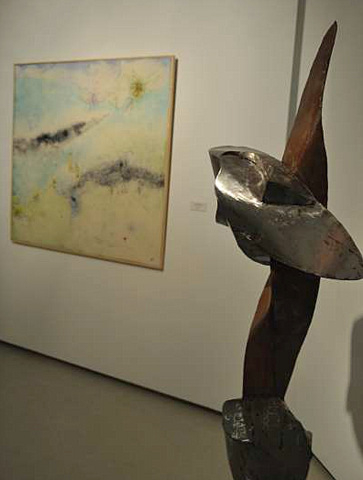
He is also responsible for a significant number of works in city centres and parks around the world. His sculptures are particularly popular in America, an example being the series of pieces created in honour of the 400th anniversary of Miguel de Cervantes, creator of Don Quijote, displayed in New York and in the Chelsea Art Museum in London.
Cristóbal Gabarrón was born in 1945 in Mula in the north-west of Murcia but grew up in Valladolid, and by the age of 19 had presented his first exhibition, beginning a lifetime of travel and development of his art. Although his chosen mediums vary through his lifetime, the common thread of the message he transmits and the core issues which preoccupy him in his work remain constant.
Gabarrón is a master of different media, and the pieces displayed in the Casa Pintada reflect his constant process of experimentation with materials and forms, each material expressing a different nuance, a different message: soft and tactile clay, an earthly and natural material used by mankind as a material for expression from earliest prehistory; wood, a warm and sinuous material, organic and tactile; iron, durable and malleable, the heart and soul around which his pieces are formed; harsh steel, a dynamic and forceful material with strong impact and durability; sinuous industrial fibreglass, which can be torn and teased to create space and openness, but also signify gaping space and emptiness; soft canvas and brittle glass, each manipulated and woven into a symbolism-laden creation and part of a journey through life.
Gabarrón has often been called a “colour humanist”, using his art to express the theme which preoccupies him in all his works. “People are what concern me most", he explained to Murcia Today during the inauguration of an exhibition dedicated to his work in the Regional Contemporary Art Museum, the MURAM in Cartagena.
 “People, relationships, life, death, love, the constant struggle between the internal and external worlds within our lives, and the destructive forces which fight within all of us, the goodness of humanity, but also our own capacity for destruction and injustice.”
“People, relationships, life, death, love, the constant struggle between the internal and external worlds within our lives, and the destructive forces which fight within all of us, the goodness of humanity, but also our own capacity for destruction and injustice.”
And the messages are expressed by subtle symbolism in every piece. “The African series expresses the injustice of what we have done to the country", he explained, “the rape of Africa for materials, for wealth, for minerals, it’s wrapped in cord to symbolise its slavery and the injustice it suffers". The materials chosen are soft primeval clay and primitive wood, echoing the naïve schematic art of early cultures, raw cord, earthy and simple, with industrial iron binding it tight, the exploitation of natural resources, soft earth tones emphasising the vulnerability and child-like naivety of the continent, bared open for those who are tearing it apart.
“I don´t agree with what’s happening in the world", he explained, “I say what I want to say through my work. Each of us has a voice in our own way and my art invites the onlooker to reflect. I propose questions".
“I see inspiration in everything,“ he said, even in the current social situations in Spain today caused by economic crisis. He explained how each of us uses our own means to put across a point of view, so a writer uses words to call on the public to reflect, proposes points to stimulate a response, and this is the effect he 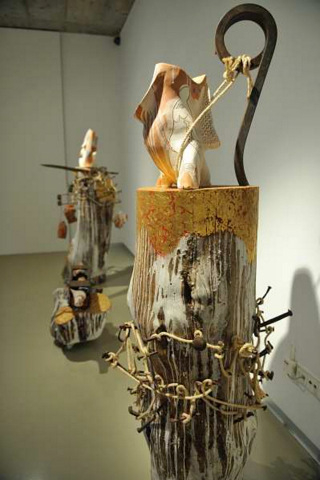 wants his art to have on those who go and look at his exhibition and other works in public places. "People don´t spend enough time just looking at art", he insisted, “I want people to just look, to see, and to observe".
wants his art to have on those who go and look at his exhibition and other works in public places. "People don´t spend enough time just looking at art", he insisted, “I want people to just look, to see, and to observe".
Hence the passion for creating art in places used on a daily basis, taking art into the parks and open spaces, making art a non-elitist gift for all as part of their daily lives.
The Casa Pintada holds several of his large-scale canvases, all laden with symbolism, each series with changing tones and colours, reflecting different phases of his career, and the constant preoccupation of the artist with these same themes: Wamba 6, skulls and dark blues with powerful black accents. What am I looking at, what’s this all about?
A map of the heavens, a universe out of alignment, the planets clashing and colliding, represented by human skulls, a collision between man as creator and the destructive forces which tip us out of alignment within our own universe and our own instincts which cause constant friction between compassion and cruelty.
Canvases scarred, subtle jagged lines, broken lines, a break in continuity, the wounds of the earth, scars 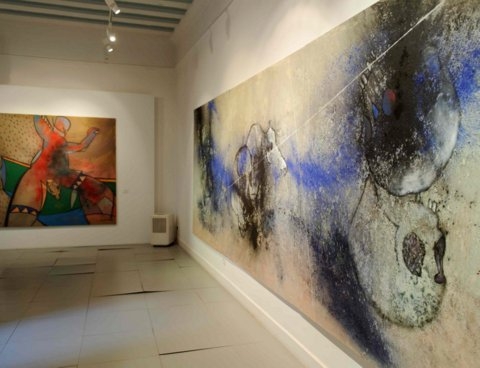 which remain inside us, barely visible yet never healing completely, always creating a disharmony and always below the surface, no matter how soft and tranquil the surface colours.
which remain inside us, barely visible yet never healing completely, always creating a disharmony and always below the surface, no matter how soft and tranquil the surface colours.
Series of canvases which explore our emotions, “Rectangular”, “circular”, “internal landscape,“ and “my demons” inviting reflection, seeking to open a curiosity to explore and speculate about what is being conveyed in each image. Colourful expressions of nature, yet with an essentially anthropocentric character, meaning that Gabarrón considers humanity to be the most dominant planetary force around which much of what happens to the world today is focused.
The works seek to remain in constant dialogue with the spectator, subtle tears exposing fibreglass, creating different dimensions to the works, and the changing imagery portrayed, “I now understand life a lot better than I did when I was younger", the artist explained when questioned about the increased vibrancy of the colours selected, “but I'm still preoccupied by the same themes as 30 years ago", he said: “injustice concerns me the most".
And injustice is the subject which is so starkly visible in the most important works of his public sculptures, the 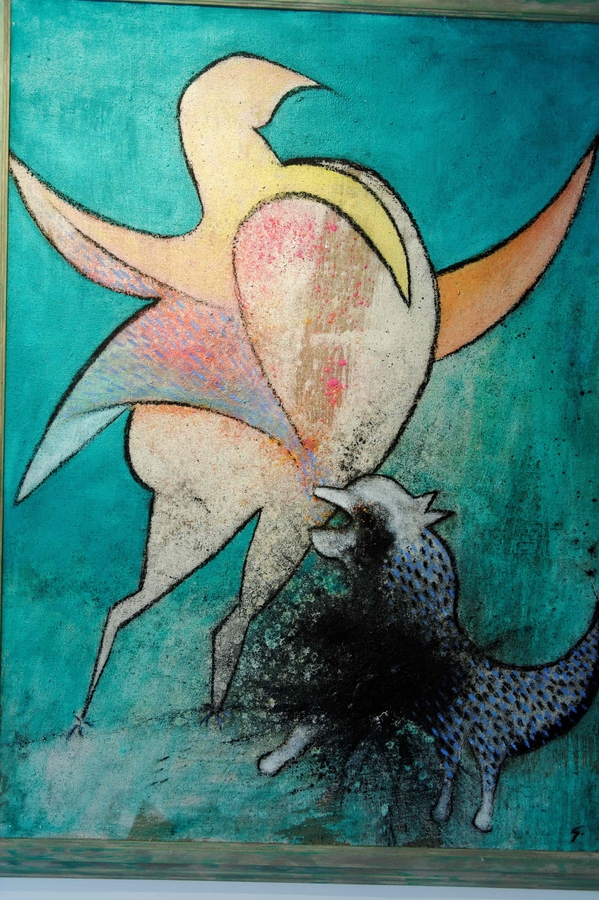 “Empalados”, brutal steel stakes tearing and splitting through the sculptures of glass, enamel and wood.
“Empalados”, brutal steel stakes tearing and splitting through the sculptures of glass, enamel and wood.
Gabarrón explained that the use of a stake as a method of torture or execution had been widely used throughout history, the most renowned instance being Vlad the Impaler, who is recorded as having impaled 23,000 people in one day as a reprisal for 10 years of incarceration by a ruler from whom he had sought help but who had instead thrown him into a solitary prison cell.
The concept of impalement had many implications, amongst them the idea that we are constantly impaling ourselves through our own self-destruction, but that we continue to impale our own world and our society through our actions. These pieces bear the same scars seen in the paintings, wounds, tears, lines, a representation of the damage being inflicted on the environment and ourselves, a brutal impaling of our world and the future of our children.
“This is what we’re doing to our world today", he says, fingers caressing the scars in the metal, “I just want people to look at this and reflect".
However, conversely, from destruction and a splitting apart is born new life, destruction being inextricably bound to new creation, a release of tension, a sating of desires, an opening of the mind acting as the 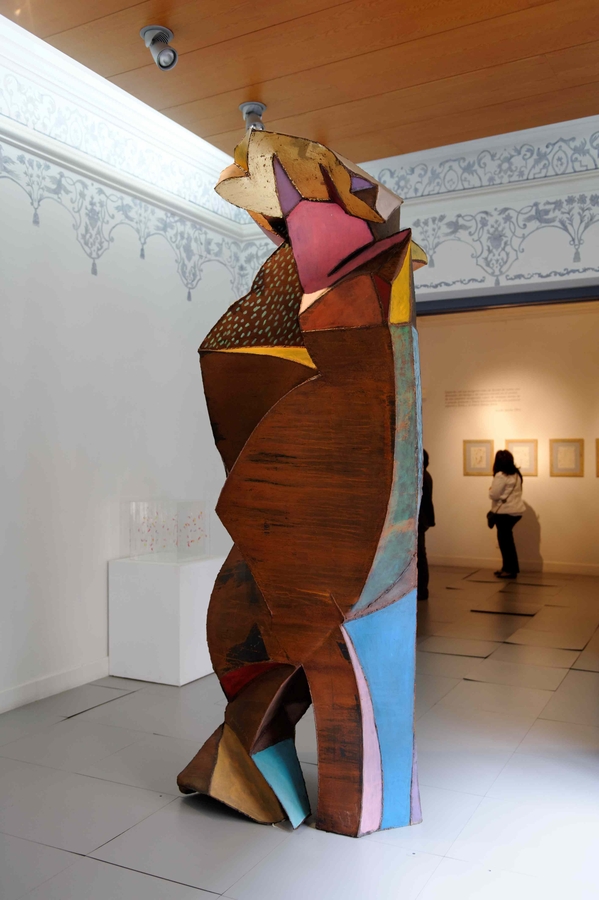 forbears of new life and new creation.
forbears of new life and new creation.
“Look and reflect", says Cristo´bal Gabarrón, “Just look and be open".
The Casa Pintada
The Casa Pintada in Mula holds a permanent exhibition of works by Gabarrón and can be visited throughout the year. There is also a park named in his honour containing a large sculptural centrepiece by the artist.
Gallery: Images from MURAM exhibition:
Cartagena
El Carmoli
Islas Menores and Mar de Cristal
La Manga Club
La Manga del Mar Menor
La Puebla
La Torre Golf Resort
La Union
Los Alcazares
Los Belones
Los Nietos
Los Urrutias
Mar Menor Golf Resort
Pilar de la Horadada
Playa Honda / Playa Paraiso
Portman
Roldan and Lo Ferro
San Javier
San Pedro del Pinatar
Santa Rosalia Lake and Life resort
Terrazas de la Torre Golf Resort
Torre Pacheco
Aledo
Alhama de Murcia
Bolnuevo
Camposol
Condado de Alhama
Fuente Alamo
Hacienda del Alamo Golf Resort
Lorca
Mazarron
Puerto de Mazarron
Puerto Lumbreras
Sierra Espuna
Totana
Abaran
Alcantarilla
Archena
Blanca
Corvera
El Valle Golf Resort
Hacienda Riquelme Golf Resort
Lorqui
Molina de Segura
Mosa Trajectum
Murcia City
Peraleja Golf Resort
Ricote
Sucina
Condado de Alhama
El Valle Golf Resort
Hacienda del Alamo Golf Resort
Hacienda Riquelme Golf Resort
Islas Menores and Mar de Cristal
La Manga Club
La Torre Golf Resort
Mar Menor Golf Resort
Mazarron Country Club
Mosa Trajectum
Peraleja Golf Resort
Santa Rosalia Lake and Life resort
Terrazas de la Torre Golf Resort
La Zenia
Lomas de Cabo Roig

CAMPOSOL TODAY Whats OnCartagena SpainCoronavirusCorvera Airport MurciaMurcia Gota Fria 2019Murcia property news generic threadWeekly Bulletin

